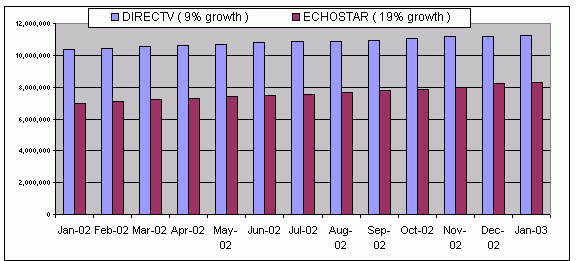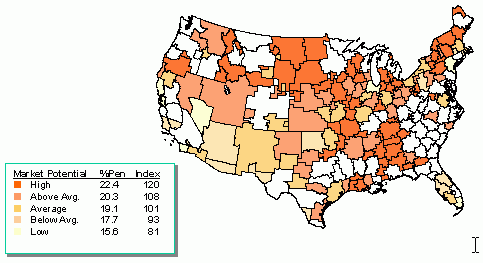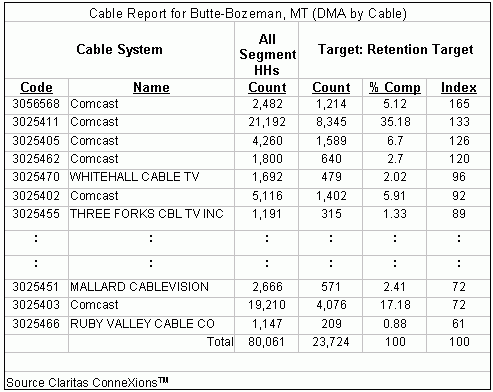
* Source: SkyREPORT
While some may rush to judgment regarding what has gone wrong, others see the recent trend as an opportunity to shift the paradigm from the acquisition-focused approach of "adding every subscriber you possibly can" to a more closed-loop system that incorporates elements of retention, as well as acquisition. If the goal is to align disparate acquisition and retention initiatives, then a key ingredient in that effort is utilizing marketing information, such as active and inactive customers, category buyers and, if possible, customers of key competitors.
These components of marketing information are applicable for cable as well as any other industry including retail, telecommunications or financial services.However, regardless of the industry, it is the latter two categories - consumer behavior and category and competitive information - that are often the most enlightening, yet the most difficult to attain.
Often, the integration and application of diverse sources of marketing information can be challenging. With household level segmentation systems like Claritas' ConneXionsTM, multivariate and distinct data can be analyzed at the customer, category and market level. For retention marketing, geographic depictions of risk and opportunity provide additional insight when developing a closed-loop system. For cable operators, this may include everything from standard market analyses for prioritizing digital upgrades to ranking ZIP+4's or households for acquisition or win-back programs.
A Case in Point
To demonstrate the integration of customer and category information
and the use of geographic analyses to prioritize acquisition and retention
initiatives, Claritas' Convergence AuditTM survey was used to prioritize
markets based on the potential for direct broadcast satellite (DBS) usage.
 The above map shows high market potential in rural pockets of territory,
spread across the Southeast and the Northwest.However, when we take a
closer look, there is evidence of high potential in exurban markets, including
Nashville, TN, a DMA with over one million households (index =119), Harrisonburg,
VA, the home of the University of Virginia (index = 129) and Jackson, MS,
the state capital (index =120).
The above map shows high market potential in rural pockets of territory,
spread across the Southeast and the Northwest.However, when we take a
closer look, there is evidence of high potential in exurban markets, including
Nashville, TN, a DMA with over one million households (index =119), Harrisonburg,
VA, the home of the University of Virginia (index = 129) and Jackson, MS,
the state capital (index =120).
Many of these DMAs have experienced population growth greater than the national average, as many Americans are choosing to raise their families in more exurban environments.Most of these DMAs also index higher than the national average for the percentage of single-family dwelling units. Logistically, this makes sense, since the owner of a single family home does not need the permission of a third party (apartment building owner, condominium board, etc.) to mount a satellite dish on their property.
As mentioned earlier, ingredients for a successful retention or acquisition initiative include customer, category and competitive components. To augment the market potential information above regarding DBS subscribers, we integrated other categorical behavior from our survey such as switching behavior, satisfaction with provider and speed of Internet connection which could be used to assess bundling opportunities for cable modems.
Through an analysis of this survey information, two ConneXions segments,
Wireless Home Business & Satellite Families, jumped off the page as
being pro-satellite and Internet savvy.These clusters should be viewed
as key retention targets for cable operators.Their topline demographics
are:
 A second set of targets was also developed consisting of households that
are pro-satellite but less Internet and technology driven.
A second set of targets was also developed consisting of households that
are pro-satellite but less Internet and technology driven.
Using our target segments, cable systems can be ranked to prioritize both retention and acquisition initiatives.For a test market, we chose the Butte-Bozeman, Montana DMA. Although one might think of Montana as being the epitome of rural America, a snapshot of some of the DMA's key demographics paint a picture that is quite different:
Population: 145,136The seven target segments on an aggregate basis represent 13% of the households in the US, but 29% of the households in the Butte-Bozeman market.
Age: 36.11 ( 2% lower than national average)
HH Income: $71,258 (10% above the national average)
% Adults with College Degree: 16.63% (23% above the national average)
% Single Family Homes: 64.5% (7% above the national average)
Other high ranking markets include:
 Linking our targets to cable service areas, we can prioritize marketing
initiatives within the Butte-Bozeman, MT DMA by cable system:
Linking our targets to cable service areas, we can prioritize marketing
initiatives within the Butte-Bozeman, MT DMA by cable system:

Source Claritas ConneXionsTM
Armed with this information, companies like Comcast (formerly AT&T Broadband) can proactively identify not only areas at risk for churn, but also areas of opportunity for cross-sell initiatives. For added specificity, each cable system can also be analyzed at the ZIP Code, Tract or Block Group level.
So, if "cable growth has hit a wall," service providers will find
the wall less imposing when armed with the right marketing information
and geodemographic tools to navigate around it.
The authors:
Margie Lymperis is Vice President of Practice Management at Claritas. In this role, she manages a group of industry experts who consult with clients regarding our three primary practice areas: Customer Acquisition, Cross-sell & Retention; Channel Management; and Media Planning. Specifically, Ms.Lymperis and her team are responsible for assisting the sales account teams with designing, developing and implementing integrated solutions that may include marketing information, customer segmentation, database management, delivery systems, skills development and analytic consulting services.
During her 13 years at Claritas, Ms.Lymperis has worked with a variety of clients across the spectrum of industries the company represents, including Retail, Communications & Energy, Financial Services and Media & Agency.
Prior to joining Claritas, Ms.Lymperis worked at Synovate (formerly Market Facts) for five years. As a Statistical Consultant, she analyzed marketing problems relating to product development, brand positioning, and market definition using a variety of statistical methods. Prior to this position, she was a Research Analyst responsible for all phases of a primary research study from questionnaire design to data analyses.
Educational Background:
University of Chicago, Chicago, IL: M.B.A Marketing/Finance,
1990
University of Illinois, Champaign, IL: B.S.Statistics, 1985
Frank Perazzini, a 20-year veteran in sales and marketing within the telecommunications and cable industries, is a Director with the Claritas National Sales Accounts Group. He has been with Claritas since 1998 and represents several of the largest telecommunications and cable television providers in the country.His past professional experience includes positions at Nortel Networks, Southern New England Telephone (now owned by SBC), and Citizens Communications. Frank holds a BS degree in Business Administration from Bucknell University and a Masters degree in Management from Rensselaer Polytechnic Institute.